The Apple iPad Review (2012)
by Vivek Gowri & Anand Lal Shimpi on March 28, 2012 3:14 PM ESTThe Display: In Numbers
Apple is very big on maintaining a consistent experience between its products. We see this a lot in our Mac reviews where it's not unusual to see similar white points across virtually all Apple products. It's no surprise that the with the move to the Retina Display Apple wanted to retain as much of the original iPad's display characteristics as possible. We'll start with an analysis of brightness and contrast, both of which remain relatively unchanged from the iPad 2:
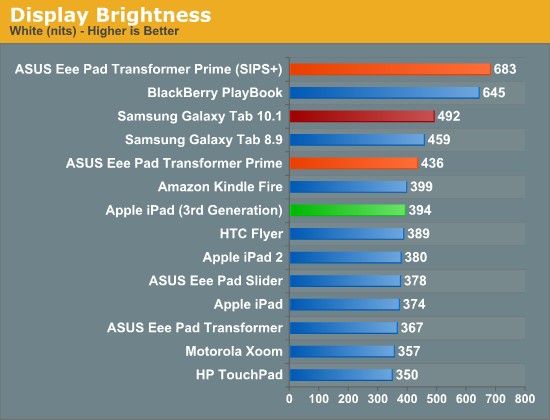
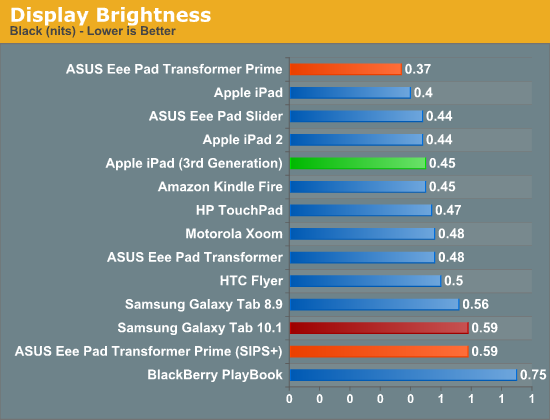
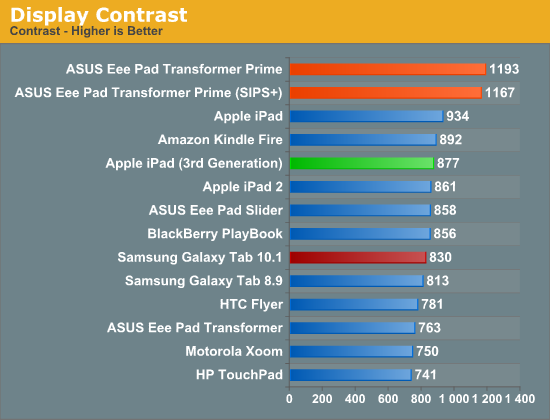
Apple is expected to have triple sourced panels for the new iPad, so you can expect to see variation in these results but for the most part you can expect the new iPad's display to perform similarly to the previous model.
Despite similar brightness and contrast to the previous model, the new iPad offers remarkably better color gamut and color reproduction than its predecessor. Relative to other tablets, the iPad's display is spectacular.
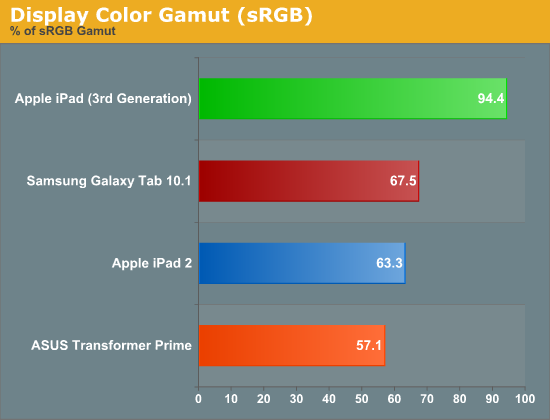
As we mentioned in our Retina Display analysis, Apple delivered on its claims of a 44% increase in color gamut. The new iPad offers nearly full coverage of the sRGB color space and over 60% of the Adobe RGB gamut:
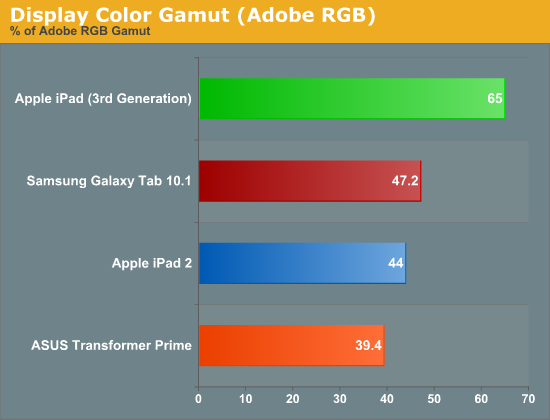
Below is the CIE diagram for the new panel with an sRGB reference plotted on the same chart so you can visualize the data another way:
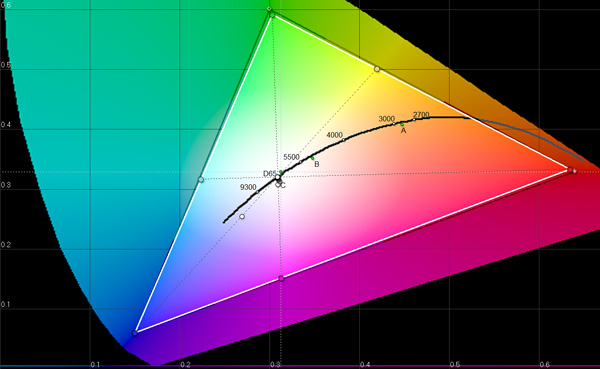
Color accuracy has improved tremendously if we look at delta E values for the primary and secondary colors:
Remember from our display reviews, lower delta E values indicate greater color accuracy. Values below 4 are typically considered good and you can see that the iPad 2 as well as the Transformer Prime both fell short in this department. With the new iPad Apple has clearly focused on color accuracy, which makes sense given it was used as the vehicle to introduce iPhoto for iOS.
Apple still has a lot of work ahead of itself to really put forth a professional quality display in a tablet, but for now the Retina Display is easily the best we've seen in a tablet and a tremendous step forward.
What's most absurd about the iPad's Retina Display is that you're able to get this resolution and panel quality in a $499 device. While we must be careful not to give Apple too much credit here as Samsung, Sharp and its other display partners clearly make the Retina Display, it's obvious that Apple has really been pushing its partners to develop solutions like this.
The biggest problem in the production of any commoditized component is the primary motivation for innovation is to lower cost. For years I argued with notebook PC makers to use higher quality LCD panels but no one was willing to commit to the quantities that would lower costs enough. I was also told that as soon as you put these notebooks on shelves at Best Buy, users wouldn't really care whether they were getting a high quality IPS display or not—all that mattered was the final price.
Apple, under the leadership of Steve Jobs, had a different mentality. Steve's pursuit was quality and experience, cost was a secondary concern. Through slow and steady iteration of this approach, Apple was able to build up a large enough customer base and revenue to be a significant force in the industry when it came to driving costs down. Apple can easily fill your fabs and eat all that you can produce, but you'll have to do whatever it wants to get the order.
Apple's behavior since it got rich has been to drive down the cost of higher quality components, LCDs being a perfect example. Unfortunately other companies don't benefit as much here as Apple tends to buy up all of the production of what it has pushed to create. That's one reason why, although ASUS was first to introduce a 1080p Transformer Pad, it won't launch until well after the new iPad. From what I've heard, the panel makers are all busy servicing Apple's needs—everyone else comes second.
Eventually the entire industry will benefit and all indications point to Apple doing something special for "pro" users in the notebook space next. As I've said previously, Apple has raised the bar with the iPad's Retina Display. The time for average display quality in a $500 tablet is over, the bar has been raised. It remains to be seen whether or not Apple will be able to maintain this quality across all suppliers of its Retina Display. On the iPhone Apple has been entirely too lax about maintaining consistency between suppliers. If it wants to be taken seriously in this space Apple needs to ensure a consistent experience across all of its component vendors.

















234 Comments
View All Comments
SixOfSeven - Thursday, March 29, 2012 - link
Any chance the glass is less likely to shatter on this one than on its predecessors?I didn't think so.
darkcrayon - Thursday, March 29, 2012 - link
The iPad 2's glass was much more resilient than that on the 1.. So who knows. I wonder if it's Gorilla Glass 2 and that's where a bit of weight savings came on the new iPad, considering the battery is so much larger yet the device is only slightly heavier.pdjblum - Thursday, March 29, 2012 - link
So you convinced yourself there is a use for it as it is "the world's greatest netbook" to your mind. Yet you can get a much more powerful intel notebook for about the same price or less. It is nothing more than an expensive indulgence. It is anything but enthusiast gear. Oh, I forgot, this has become another gadget site that loves crapple.kepler - Thursday, March 29, 2012 - link
That isn't true at all. Wait until you read the review for the Transformer Prime Infinity, it will be just as detailed, and I'm sure they'll like it just as much (or more) than the iPad3.I dislike Apple for a number of reasons, but I don't feel AnandTech has shown any bias.
darkcrayon - Thursday, March 29, 2012 - link
Not that you're anywhere close to reality, but I wonder why all these "gadget sites" seem to "love" Apple? Maybe because they make good products that people enjoy using? Naah, must be some hidden conspiracy. You're the one that knows the real deal, right?Everyone knows you can get a more powerful intel netbook for the same price. You can also get a more powerful intel netbook than smartphones which also cost more than the iPad. Oddly enough, you will not find an intel netbook on the market now with a screen anywhere near as nice as the iPad. Cool times we live in, eh?
doobydoo - Sunday, April 1, 2012 - link
Can you tell me which 'more powerful' intel notebook you can get which is capable of gaming at 2048 x 1536 at 60 fps and has a battery life over 9 hours, as well as being ultra-portable and light, instantly turns on, has a camera and built in 4G, at less than or the same price as the iPad?Good luck.
Lil Cheney - Thursday, March 29, 2012 - link
Wondering why as you review the A5x, you never use a Snapdragon chip for comparison, in addition to the Tegra 2 and 3?PeteH - Thursday, March 29, 2012 - link
Might be the lack of a shipping product to benchmark it against. The only performance numbers I've seen for an S4 came from Qualcomm's reference design.dagamer34 - Friday, March 30, 2012 - link
I'm actually not aware of any major tablets that use a Snapdragon chip. Most went with Tegra 2 early on, then moved to the OMAP 4 platform later in the year last year.siddharth7 - Thursday, March 29, 2012 - link
Well, the review is just amazing! Though its late than other sites, it was worth the wait. You went into so much of detail that I was just blown away. Photos are also great. Waiting for more reviews like this.Keep up the good work.
BTW, am I the only Indian commenting here expect the staff.
Thanks Anandtech.